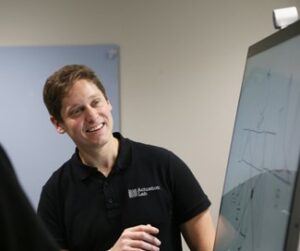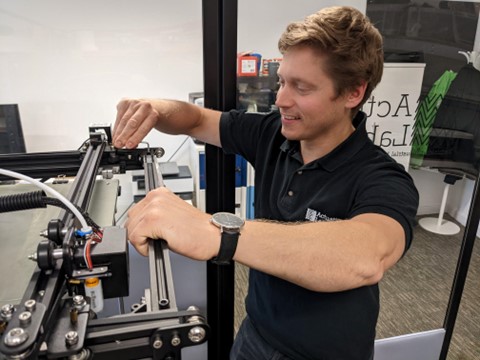Letters from the Lab #006
I’ve decided to write this blog to summarise 5 of the lessons learnt from the first 18 months since raising our first investment. I’m only scratching the surface here, but I hope someone finds these useful!
About the Author

Whilst carrying out his PhD research on 3D printing shock absorbers for the RNLI lifeboats, Simon Bates started his first company. This was a modest outfit with two 3D printers in a 2-bed Bristol flat, selling manufacturing consulting services to local engineering companies. Later, coerced by the allure of creating a business that could make a global impact, he joined Tom and Michael in starting Actuation Lab, and began ascending the steep learning curve of getting a serious hardware company from business plan to reality. Simon now works full time at Actuation Lab.
In this instalment of Letters from the Lab, he provides some insight into a few lessons learnt in his first 18 months of very early CEO life.
Lessons from the Lab: 18 months running a start-up
To set the scene, Actuation Lab have 7 staff on payroll, raised around £1.5 million funding to date, and we will have our first trial products out “in the wild” next year. We are working towards being another Bristol success story, but we have some serious graft to go!
A lot of this graft, as you would undoubtably be aware, is learning on the job. When you start up, you don’t know what lessons you will learn, or which ones you should be putting your relatively limited time into.
I’ve decided to write this blog to summarise 5 of the lessons learnt from the first 18 months since raising our first investment. I’m only scratching the surface here, but I hope someone finds these useful!
Lesson 1: Put that spanner down, you’re a people person now
Day to day, nearly everything I do is satisfy the needs of people.
This should have been pretty obvious setting out: it’s people who want your product, it’s people who decide if you get funding, it’s people who chase you for the grant report you forgot was due (this example is purely hypothetical!) and it’s people who make up your business.
Out of these people-centric pursuits, one of the most valuable but also time-consuming activities of the start-up CEO is business development or “BD”. The best definition of what BD is at this stage is talking to industry about their problems, and working towards forming relationships and collaborations, to make sure our hardware development is guided by these problems.
This is a shift in thinking for this engineer who may have once deemed the phrase “Build a better mousetrap, and the world will beat a path to your door” to have some credibility…
So, although we have been able to get a number of trial partners lined up to use our tech, they have been hard won, over hundreds of hours on video calls, innumerable site visits, or at the bar after an industry body AGM at 3am. And in most of these meetings, we have come away and fed back to the tech team about how we should consider taking the engineering forward to fit the needs of the market.
The best bit of on-the-job training I received for this sort of thinking was getting on Innovate UK’s ICURe programme. Two months of getting out of the lab and into the real world to talk to real people with real problems – well worth checking out if you are a soon-to-be university spin out.
But how do you actually get people to talk to you about their concerns, so you can develop your killer tech to solve them?

A rare sight nowadays, but Simon just can’t stay away from the 3D printers
Lesson 2: “You’d learn a hell of a lot more pretending you’re stupid” – Michael Dicker, 2021
This short, sharp, ego-busting advice from our CTO is something I’m considering having made into a motivational poster.
Imagine a scenario where you get introduced to someone you consider to be a titan of industry who may be your future customer. Intimidating, to say the least. And I will confess that in the past, a gut reaction has caused me to foolishly launch into the conversation with the subconscious aim of convincing them I am the right calibre of person to be speaking with them, as I am awfully smart (I have a PhD, don’t you know) and know all about their field.
This results in lots of me talking, or even worse, firing up an unsolicited PowerPoint. Of course, we should strive to be as well-informed as possible, but this act of showmanship, rooted in insecurity, is unlikely to lead the other person to relate to you, relax into the conversation and open up about the problems you may be able to solve in their business.
I have found that a better approach is to explain your background, be clear that you are ambitious, but near the beginning of your journey, and that you want to understand the real issues in industry. Be honest, I guess.
I try to ditch the PowerPoint in meetings and endeavour to have as human a conversation as possible, without going in too hard about what I do or don’t know. Best case scenario: it helps the other person have a good old moan about what they don’t like about their current technology options and the market, which for us is gold dust.
This lesson is really in negotiation and building relationships. This is a vast subject, so rather than attempting to give an underqualified lecture, I will point you in the direction of a few books that got me started:
- “How to Win Friends and Influence People” – the zeitgeist on personal and business interaction,
- “Never Split the Difference” – sometimes self-aggrandising, but an expansion on the first with a heavier negotiation angle,
- “The Chimp Paradox” – a guide to brains, why you and the people you are dealing with may slip into negotiating like an aggressive ape, and how to deal with it.
Lesson 3: Prototypes over PowerPoints
I have said that I try to ditch the PowerPoint where possible for business development calls and in-person meetings.
Often it helps to send a few slides ahead of a meeting, or as a follow-up so that everyone has all the details. However, the best way we have found for communicating our passion for what we are doing and actually interacting with people is to gather round a physical 3D model or wave a widget at a webcam with great enthusiasm.
Initially when doing this, I was sometimes worried that people had an expectation that I would present slides, and would be disgruntled, but rarely so.
Admittedly, you don’t have much to hide behind if you are on screen wielding a prototype or stood in a room holding a valve aloft, but I believe this makes everything you are doing feel more real, inevitable and tangible. Even if your 3D model is a hastily superglued Frankenstein creation.
So where do we get these models? Well, we 3D print everything. And while you may think this is not accessible for every business, I would argue that it is. Everyone from our Administrators to our R&D engineers have had a crash course in 3D printing at our company, and everyone is able to produce 3D models. My suggested small business/hobbyist starter pack include:
- Foolproof printer: Prusa i3 Mk3s (£599)
- CAD software: Onshape cloud based CAD (free for non-commercial use)
- Material: Filamentive recycled PLA (£30/kg)
- Getting up to speed: YouTube

3D printed prototypes of our Callimorph actuator
Lesson 4: Find yourself a few good mentors and role models
An often banded around phase here is “you don’t know what you don’t know”.
But often, a good mentor does know, or can help you quickly find someone who does. A good mentor will also act somewhere in between a strategist and a therapist when things are a bit tough.
I have noticed that the best mentors and advisors are the ones who have done some aspects of my job recently enough that the emotions they felt in that role haven’t left them yet. Our Chair Steve Kitson was one of our first mentors, and I would say he fits this category well. Other notable role models include our business advisors Jonathan White and Rob Boycott, who live and breathe the industries we want to sell into, and are always available for a call.
If you are looking for a mentor or role model, I would suggest getting yourself involved with an accelerator network (e.g. SETsquared) or industry body (e.g. BVAA), even if you just attend the drinks events and passionately talk about your ideas to people.
Lesson 5: Breed a culture where people rapidly communicate their mistakes
I have made loads of mistakes learning on the job.
I travelled to a meeting in Scotland on a public holiday, greeted by a locked door.
I have been told in no uncertain terms “don’t tell me anymore!” by a concerned audience member as I began publicly rattling off something that approached our intellectual property (a stand-up chap, thank you).
I have repeatedly promised to write a blog post concisely and promptly.
A core lesson for me has been that the quicker I fess up to any mistake or even a concern that something could go wrong, the quicker our company can work on solving it. This is obvious, but pride often gets in the way.
This is a core cultural behaviour that we are trying to instil in everyone at Actuation Lab: rapidly try things that may not work, communicate what went wrong when it sometimes does, and the team will work together to fix it. The R&D process is applied across all areas of the business.
Lessons from the Lab don’t end here
There are innumerable other lessons that I could include here, but I should probably save preaching too extensively until I have a few more scars from the journey.
I also want to express my sincere gratitude for the support that the company has received from SETsquared, QTEC, NZTC TechX and all our advisors.
As a final note, I should mention that we are going to have a number of job roles going live very soon. If you like the sound of working with us as an engineer or project manager, keep an eye out for updates!









